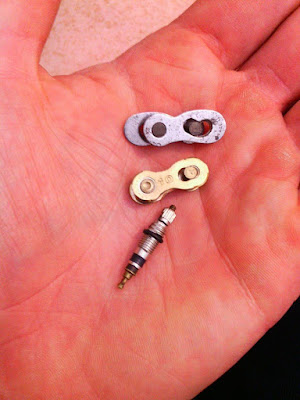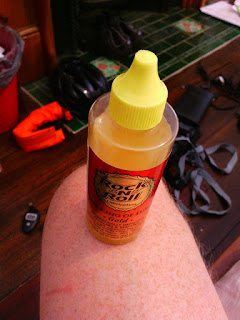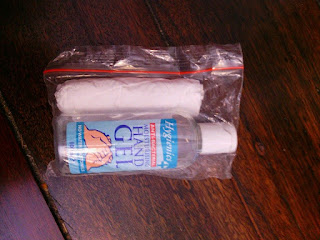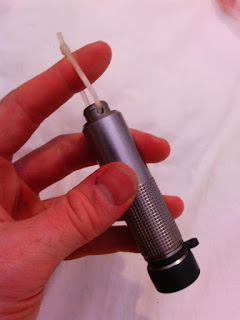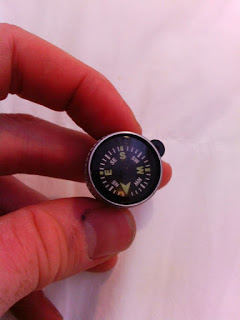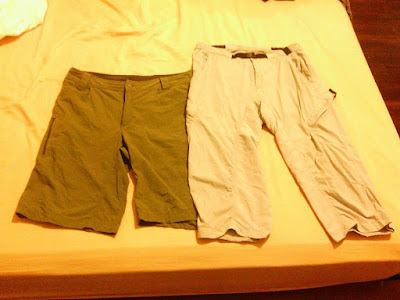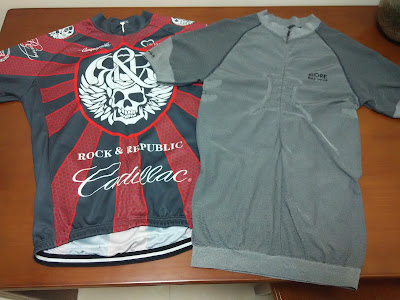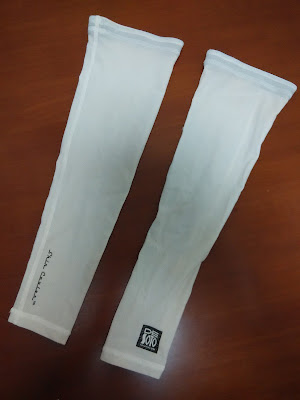Choosing what gear to pack can be quite fun or rather
anxiety-laden, depending on your personality. I’ll break down the kind of general equipment
I’ve packed (or stopped packing) for solo travel in warm-weather as a starting point to help you get
thinking. You can always go lighter or heavier depending on your situation. Clothing and bike-related tools are posted elsewhere. Feel
free to add your expertise (especially females) in the comments below!
A backpack. Weight on your body (as opposed to on your bike) is not ideal, but I recommend bringing at least a minimal pack for hydration. A CamelBak or similar hydration pack will allow you to drink on the go, carry other gear within, and be used when racing or riding unloaded. I have found that some packs designed for adventure running have a good combination of ergonomics and ample space in them for gear. I have been travelling with a Camelbak Rim Runner. Be sure to choose a pack that feels comfortable in your riding position, because not all are designed for this purpose.
Water. Depending on how you organize the load on
your bike, you may or may not want to utilize its bottle cages for water.
Getting as much weight onto your frame and off your body will aid in cycling
efficiency, however, so keep this in mind.
That being said, a CamelBak or similar pack with room for
hydration will allow you to drink on the go, carry other gear within, and be used
when racing or riding unloaded. I have found that some packs designed
for adventure running have a good combination of ergonomics and ample space in
them for gear, and have been travelling with a Camelbak Rim Runner. Be sure to choose
a pack that feels comfortable in your riding position, because not all are designed for this
purpose.
Bottled water will be readily available in many countries.
However, to be environmentally conscious, consider bringing a UV water purifier. Research the water quality of any areas you travel within, considering the
presence of bacteria, protozoa, parasitic worms, heavy metals, and other
pollutants.
In any kind of adventure, I have additional water options for backup due to water's high importance. Iodine (or similar) tablets take up very
little space and weight, and a LifeStraw might save a life under certain
conditions.
Bring your own water bottles or obtain them at your destination. If you are using a UV filter, they will need a wide mouth. If you are using bottle cages, be sure the bottles fit.
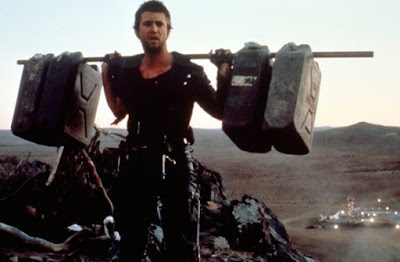 |
| Never underestimate the importance of water. |
Food/Cooking.
I don’t bother cooking
for myself anymore, since my recent destinations have made this unnecessary. If
you will be in more remote locations or will need to boil water, put together a
lightweight cooking set for yourself. Many lists and reviews online can help
you with this. This option will also require packing bulky food.
 |
| Fun, but potentially overkill. |
My recommendation is to source food locally and only bring a
few items with you such as energy gels and power bars as a space-conscious backup.
Bananas are often plentiful as are street food and restaurant options. Enjoy the local eats!
Bedding. The
difference between a good night’s rest and a bad night’s rest is significant
when you are involved in highly physical activity. As always, there are a number of
options here.
Hostels and guesthouses are a cheap way to access a
(usually) soft bed, toilets, shower, water, human contact and internet. For
these reasons (primarily the last), they have become my first choice. Research to
find what options are available along your route and know that there will be
more that are unlisted on maps.
To save money and be self-sufficient, pack your own
sleeping gear. An ultralight tent can be useful, though expensive
and taking up significant space. Dropping down to a lightweight bivy sack like
the OR Helium will provide protection for one with a minimal cost of weight and space. A lightweight camping hammock is also an option, but bugs and
inclement weather may require you to add additional protection.
 |
| Also fun, but potentially overkill. |
I split the difference on my last trip by packing an
inflatable camping mat coupled with a mosquito-repellent blanket and just my own
(clean) clothes for a pillow. You may find abandoned sun shelters or other structures along your route that simply need the addition of a bed to offer some rest.
 |
| Blanket and mat lashed to my handlebar. |
Finally, consider making new friends. You will meet locals
in the countries you travel, and many will be happy to invite you in for the
night. Use your own best judgment here, and know that if all else fails, a
temple, church, or monastery will be willing to let you sleep on their
floor. Just remember to make an appropriate offering in response to their hospitality.
First Aid. There
are many great resources online for building a first aid kit for your
particular needs, so I won’t go into anything too specific here. But have one!
Alcohol wipes and hand cleanser (see Bathroom Kit below) will be essential to
include in this.
Medicine. To
complement your first aid kit, pack any personal medications as well as
considering broad-spectrum antibiotics for skin and lung infections due to bacteria (not viruses), antimalarials, and over-the-counter medicines for stomach pain and diarrhea. Consider your travel routes and know what health hazards are present. A general practitioner can always offer advice and prescriptions, too. Some of these drugs may be available in-country, but be careful of the source.
Bathroom Kit and Toiletries. Carry
tissues, hand cleanser and possibly a camp shovel if you will be making
deposits in places other than bathrooms. Wash your hands!
Your toiletries should at least include a (sawed-off?) toothbrush, toothpaste, some form of deodorant, vision items (glasses, contact lenses, case, solution, etc.), sunscreen, lip balm, mosquito spray/cream, and a mirror (see "Signalling" below). Soap, a travel washcloth, dental floss, earplugs, and a sleeping mask are optional. If your first aid kit includes scissors, use these instead of a nail clipper for longer excursions.
 |
| D'oh! |
Other essential items. There
are a few conditions you may run into (especially when travelling solo) where
having the right item will make a huge difference. Decide which conditions you are likely to face and pack accordingly.
Sunglasses. Riding glasses with lenses for three types of conditions (bright sun, wooded/overcast, and night) are very useful. You can always get by with cheap sunglasses (often readily available on your route) but in my experience, the investment in a comfortable pair with quality optics makes things safer and more enjoyable. Glasses will also protect your eyes from tree branches, particles, and rain.
A multi-tool. You should have appropriate bike tools packed,
but there are times when a knife or pliers will be important. Due to the heavy weight of these, choose wisely. I have settled on the Leatherman Skeletool for
my travels. I don’t think that a separate fixed or other blade is necessary
unless you are looking for trouble in one way or another.
 |
| Definitely overkill. |
A flashlight. As a practice I do not ride much at night, so I do not pack bike lights. A hand torch/flashlight and/or a headlamp are good to carry, though, and with a bit of cordage you can always mount a flashlight to your handlebars.
Navigational tools. I
wear a Casio Pathfinder (which includes a compass) but I also carry a small
liquid compass with storage for other items in its body (see below). If you are
using GPS tools in one form or another a compass may seem unnecessary, but I
still need to get my bearings at times if only on a street corner at night
when headed home. If you plan to navigate by paper map, choose appropriately.
A tablet/phone/phablet is a good item to bring for so many
reasons, and just one of them includes access to on- and offline maps to interface with your device's GPS capabilities. Some of these apps will allow you to even
edit their maps with places you discover.
Carry paper maps (or sectionals) and/or utilize offline maps
on a device when travelling in unknown areas.
Communication tools. This may be the same item as above. International or local SIM cards will get you connected, though I've gotten by using communication apps and WiFi. For safety's sake when solo, however, an active mobile phone is essential.
If you bring an electronic device, be sure to protect it in some way. You don't necessarily need a $60 OtterBox, but protection from weather and impact will be important. On a budget, a ziploc freezer bag and a small padded shoulder bag will do the trick. Also look for small-sized Tupperware (or similar) containers with rubber seals.
Music. This might be your mobile phone or tablet, but in truth, my recommendation is to leave it at home. I love to ride fast on home turf listening to music, but that's a different game. Open yourself up to what's around you in a foreign land.
Camera/Pics. As above, this could be your phone or tablet. And I do recommend doing this. Even a GoPro or such is a great addition to your gear for the sake of sharing your life with locals as well as those back home. Heck, get hip and bring a Polaroid camera if you want; it's a great way to gift new friends with a memory.
Power. You will need a variety of cables to power your devices; consider multi USB adaptors and/or cutting down the length of cables. Research the voltage and style of power outlets in your destination, and also consider power banks and solar-powered chargers. If any devices require batteries, make sure you are supplied.
Signalling items. If you are injured or lost, a few items might make the difference. Always have one of the loudest safety whistles available within close reach and/or wear a pack with an integrated whistle in the shoulder harness. A mirror, laser pointer, and glow sticks will allow you to make yourself visible to others under different conditions; choose what is appropriate for your trip. Even if you don't use these items for rescue, they can all be used for entertainment purposes with locals!
Fire. I don't see the need for these items typically (especially in warm-weather), but you may want to consider matches, flint & striker, a lighter, and tinder/fuel if you are cooking, launching fireworks, or chomping on a cheroot.
A general repair kit (not for bikes). In the body of the above-mentioned compass, I have waterproof matches, buttons, thread, needles, and bobby pins. I suppose you could catch and cook a fish with these, but they work better for clothing and gear repair. I also have some patches and glue for things like tents, raincoats, and the like. If duct tape weren't so bulky, I would consider it.
Cordage. Paracord or other flexible cords are great for lashing gear to your bike and for setting up camp if you happen to go this route. I also find tons of stuff to improvise with by the roadside.
Cable/zip ties. (Also included in Bike Tools post) Get a few sizes. These are great for so many things.
Bartering goods. This is an interesting one, but keep in mind items that may be useful to trade with locals. I have found that militaria and Zippo lighters do well, especially if their cultural identity is quite different from (and respected by) the foreign culture you are in. I used to trade Smith & Wesson H.R.T. knives quite often, and recognizable pop icons like Rocky and the US Marines or Harley Davidson emblems on a lighter can be quite appealing to men. I have also traded things like US infantry caps to drivers for rides across the island of Cyprus. Try your hand at the trading game!


